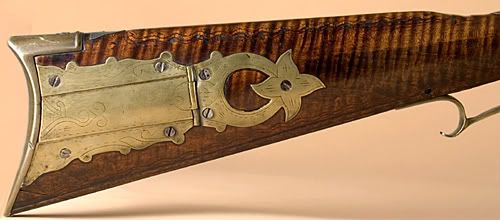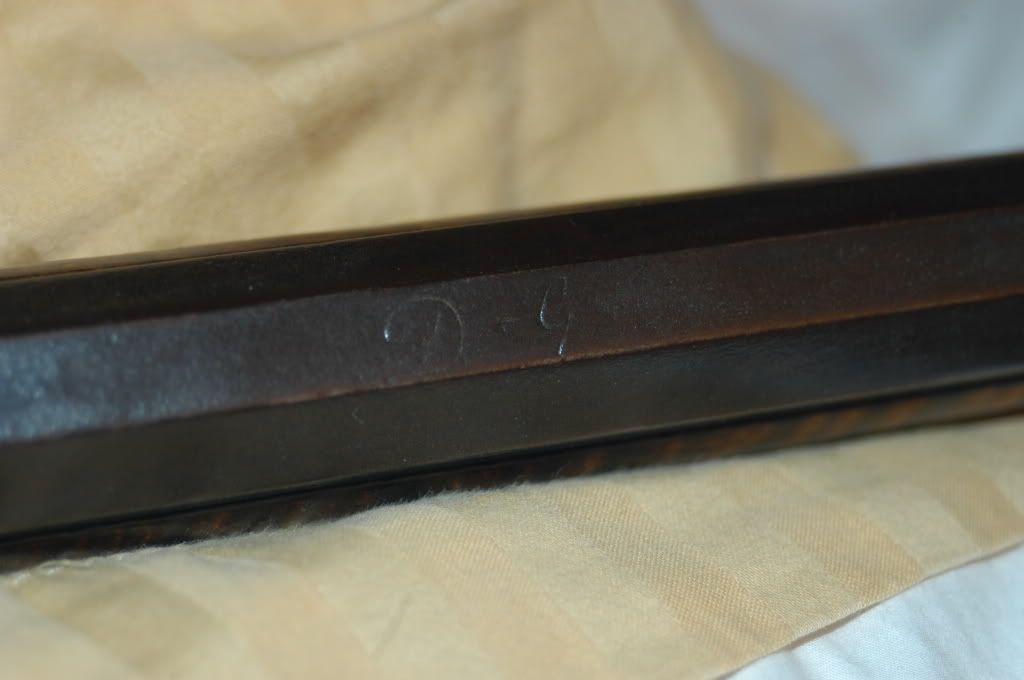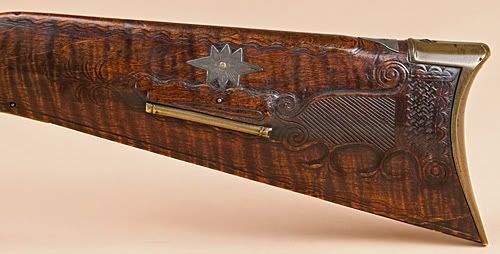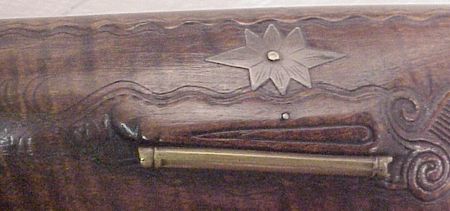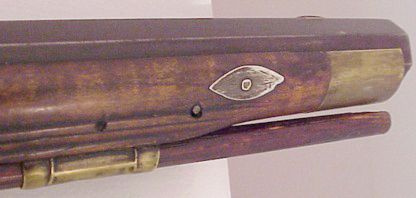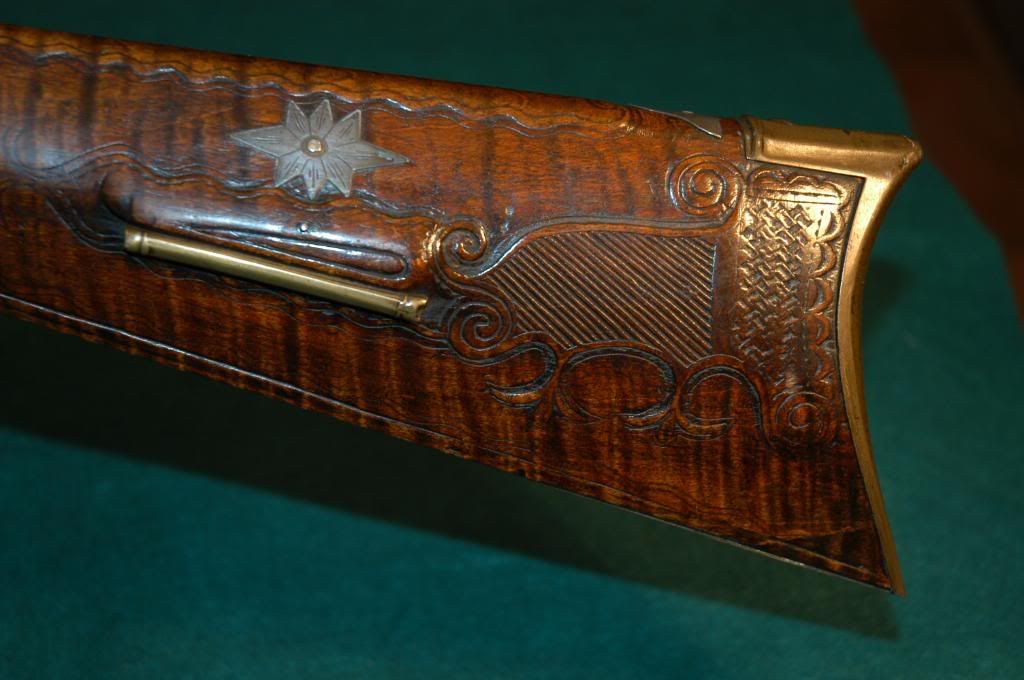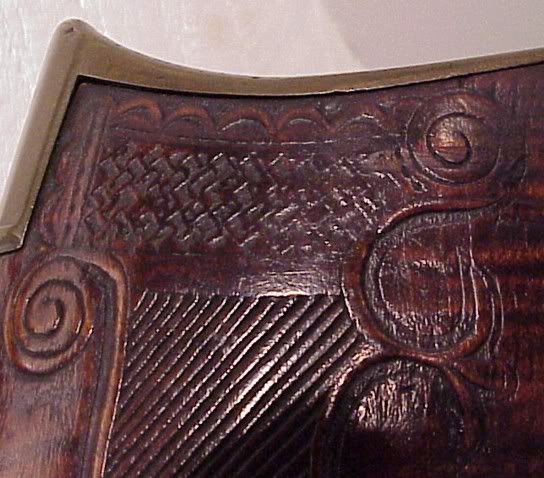David Grose Longrifles
This gun is atypical of the guns most commonly attributed to Grose. The typical gun, shown elsewhere, reflects the more traditional North Carolina style most commonly associated with David Grose. The information below is contributed by Michael Briggs.
--------------------------------------------------------------------------------
Last week I told you about Thaddeus Gardner. The second of the three men at I attribute to starting the Guilford County Longrifle School is David Grose.Prior to the founding of the Jamestown area School, there was an earlier school centered on the Randolph/Guilford County line that my friend Bill Ivey calls the Lower Deep River School. It is also refered to as the Centre Meeting School after the Quaker Church that was started in that area in 1757. There was supposedly a gunsmith who was a member of the church named Matthew Osborne that was upset to learn that one of the Longrifles that he had made was used at the Battle of Guilford Courthouse that he repurchased the rifle an bent the barrel and broke the stock to make sure that it would not be used again to take a human life. Another gunsmith that we have identified in this school is Alexander Frazier of Randolph County. John Bivins book The Longrifles of North Carolina features a wonderful signed relief carved rifle signed by Alexander Frazier. There is a debate locally about who actually made the second rifle that Bivins attributes to Frazier in the book. Also Bivings puts Frazier in the Rowan School which we now know is incorrect as Frazier always worked in Randolph County. There are a small group of Longrifles that survive from this school. There are four early Longrifles that are unsigned that feature sliding wood or hinged wood patchboxes. One is on display at the Greensboro Historical Museum in their Revolutionary War Display area. There are also three rifles with early brass beehive style patchboxes. The most important architectural feature found on rifles in this School is that most have a triple bead line running along the bottom of the stock from the butt plate to the trigger guard. This same triple bead line is then repeated along the fore-stock from the entry pipe to the last ramrod thimble. The Longrifle as the Greensboro Museum has both of these features. There are two early Longrifles that have surfaced locally that are signed by David Grose. Both Longrifles feature the architecture of the Lower Deep River or Centre Meeting House School which would indicate to me that David Grose must have apprenticed or worked in that School before he moved to Guilford County.David Grose first turns up in the records of the Guilford County Court in 1805 when the court binds an orphan named John Conner to him to Learn the Art & Mystery of a gunsmith. In 1806 the Guilford County court also binds a 14 year old orphan to him named David Muly to serve as an apprentice. In that same year David Grose purchased 120 acres from Jesse Williams for the price of $360.00. The land was fronted by the Old Salisbury Road (now called Friendly Ave.) and bordered on one side by Horsepen Creek and on the other by New Garden Friends Meeting (a quaker church started in 1748). David Grose built a house and gun shop beside the church. He worked there until 1821 when he moved to Vigo County, Indiana to the community of Terre Haute. According to Levi Coffin, an early leader of the Undergound Railroad, David Grose did not believe in slavary and tried to help a local slave named Samuel escape when he moved, but Samuel was captured in Wythe County Virginia on the trip west and returned.These are the only two signed David Grose Longrifles that have surfaced have locally. My good friend Bill Ivey found this first rifle. It is virtually untouched. The barrel length is 48. It is the only local rifle I have seen with a locally made lock. Please notice the triple bead lines on the bottom of the stock.
Michael Briggs
This gun is signed " D+G" as are the two Michael Briggs refers to in his monograph on North Carolina guns. The barrel signatures are identical, yet there is no other resemblance to the North Carolina Schools of Gunsmithing. Many have felt it is Virginia in origin. Thus it is challenging to try to understand when and where Grose ( Gross) was when he made this gun. Unquestionably this is not a replaced barrel for this gun. It is extraordinarily carved and there is no restoration.
This gun once resided in the Joe Kendigs, Jr Collection. This is documented in Chandler's "Kentucky Rifle Patchboxes & Barrel Marks", published 1971-72, page 158. Roy Chandler personally confirmed that he photographed this gun in Kendig's gun room.

